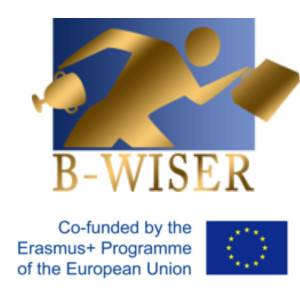Research
Performance psychology is concerned with the question of how and under what conditions people can consistently achieve outstanding performance in areas where it matters. Cognitive, emotional, and psychophysiological potentials are identified and strategies are developed to exploit them.
The research focus of our department is on applied and basic research at the behavioral level, incorporating neuropsychological methods.
We are always looking for volunteers for ongoing studies. If you would like to support our research, you can register with a short e-mail in our database. We will inform you about upcoming experiments at regular intervals.
On this page you will find information about the following aspects of our research:
Research Areas
Graduate School "Embodied Choices Cologne”
Research Laboratories
Research Projects
Research Areas

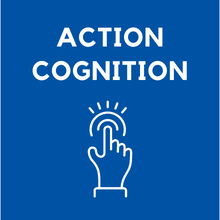
Performance psychology research in our department is divided into four major areas. The reciprocal relationships between the components perception, cognition, emotion, and action are investigated from a dynamic and probabilistic model perspective. Among others, we deal with motor learning and control, implicit and explicit learning, feedback and instruction, and judgment and decision making.
Emotion Cognition
PD Dr. Dr. Sylvain Laborde, Dr. Laura Voigt, Prof. Dr. Dr. Markus Raab
- functional link between emotion and cognition and its influence on sport performance
- emotion regulation (biofeedback, slow paced breathing)
- individual differences (emotional intelligence, intuition, reinvestment)
- heart rate variability, hormones
PD Dr. Dr. Sylvain Laborde, Dr. Uirassu Borges, Prof. Dr. Dr. Markus Raab
- functional link between emotion and cognition and its influence on sport performance
- emotion regulation (biofeedback, slow paced breathing)
- individual differences (emotional intelligence, intuition, reinvestment)
- heart rate variability, hormones
Cognition Perception
Dr. Alexandra Pizzera, Dr. Laura Voigt, Prof. Dr. Dr. Markus Raab
- functional link between cognition and perception
- embodied sports officiating
- visual attention
- judgment and decision-making
- cognitive and motor control
- performance monitoring
- psychophysics
- kinematics
- psychophysiological methods (EEG, eye-tracking, HRV)
Dr. Alexandra Pizzera, Dr. Laura Voigt, Prof. Dr. Dr. Markus Raab
- functional link between cognition and perception
- embodied sports officiating
- visual attention
- judgment and decision-making
- cognitive and motor control
- performance monitoring
- psychophysics
- kinematics
- psychophysiological methods (EEG, eye-tracking, HRV)
Perception Action
PD Dr. Florian Loffing, Prof. Dr. Dr. Markus Raab, Dr. Lisa Musculus
- functional link between perception and action
- cognitive psychology
- motor control, judgment and decision-making, embodied cognition, dual-task performance, prediction, joint action
- behavioural data (response times, errors, kinematics)
- transcranial direct current stimulation
PD Dr. Florian Loffing, Prof. Dr. Dr. Markus Raab
- functional link between perception and action
- cognitive psychology
- motor control, judgment and decision-making, embodied cognition, dual-task performance, prediction, joint action
- behavioural data (response times, errors, kinematics)
- transcranial direct current stimulation
Action Cognition
Dr. Babett Lobinger, Dr. Lisa Musculus, Dr. Dennis Redlich, Prof. Dr. Dr. Markus Raab
- functional link between action-cognition, embodied cognition
- motor-cognitive and expertise development
- theory-based diagnostics and interventions for athletes, coaches, parents and referees
- competition data (response times, kinematics, learning and performance scores)
Dr. Babett Lobinger, Dr. Lisa Musculus, Dr. Dennis Redlich, Prof. Dr. Dr. Markus Raab
- functional link between action-cognition, embodied cognition
- motor-cognitive and expertise development
- theory-based diagnostics and interventions for athletes, coaches, parents and referees
- competition data (response times, kinematics, learning and performance scores)
Graduate School
Since 2021, our department is home to its own graduate school - the "Graduate School of Embodied Choices Cologne" (ECCo). It currently has seven researchers from sports science and psychology, the majority of whom are PhD students. Together, they are working on the question of how body, mind and environment interact in complex behavior. The Graduate School aims to extend existing theories by recombining existing research approaches and developing novel approaches. The expertise of the research group ranges from basic research in the laboratory to applied field research, using a wide variety of measurement tools.
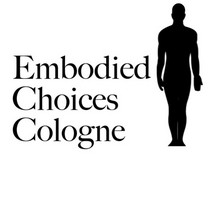
Research Labs
Our department includes a total of six laboratories equipped with a variety of modern measuring instruments.
These include:
- Electrocardiography (ECG)
- Electroencephalography (EEG)
- Transcranial magnetic stimulation (TMS)
- Spirometry
- Eye-Tracking
- 3D-Motion Capture (VICON system)
- Hydrojet massage
- Interactive climbing wall (CLIMBLING)
- Ergometers
- Treadmills
- Photoelectric barrier
- Vienna test system
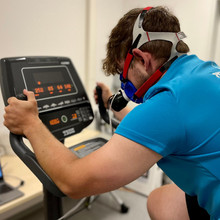
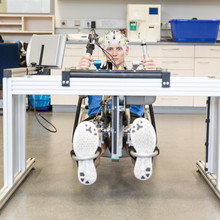
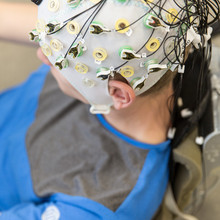
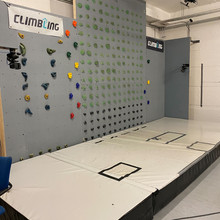
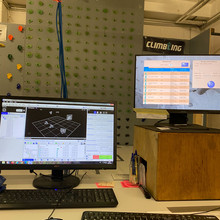
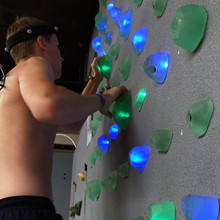
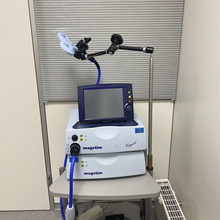
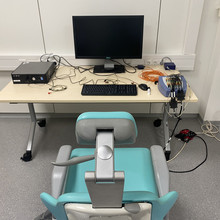
Research Projects
The following list of ongoing and completed projects of our department is divided into externally funded projects (i.e., funding by public, competitive research funding) and PhD projects.
Ongoing externally funded projects
DFG: Climbing to Yourself
A developmental embodied cognition perspective on the relationship between the minimal self and sensorimotor and cognitive abilities
Project management:
Prof. Dr. Dr. Markus Raab
Dr. Lisa Musculus
Prof. Dr. Azzurra Ruggeri (Technische Universität München)
Projekt collaborator:
Laura Juppen (Wissenschaftliche Hilfskraft)
Duration:
Oktober 2018 - Januar 2024
Funding:
Deutsche Forschungsgemeinschaft (DFG)
Project details:
The objective of this project is to understand the bidirectional link between the minimal self and sensorimotor as well as cognitive skills from a developmental embodied cognition perspective. By integrating cognitive, developmental and movement science, we tackle one of the ultimate goals of the SPP call by exploring how core mechanisms (i.e., internal models, reafferences) generate a self in the course of ontogenetic development (i.e., across the lifespan) or the acquisition of expertise (i.e., training sensorimotor and cognitive skills). Specifically, we will answer one of the five questions of the SPP call: “How does creating and having a self work back on sensorimotor skills and cognitive processes?” From a developmental embodied cognition perspective, this question cannot be answered without considering the bidirectionality between the minimal self and sensorimotor and cognitive skills. Theoretically, we propose the mechanism that optimizing the internal model by integrating sensorimotor reafferences and cognitive feedback will lead to a stabilization of the minimal self. In turn, the stability of the minimal self will foster sensorimotor and cognitive skills. To scrutinize this mechanism, we will conduct two large-scale studies. In Study 1 we will investigate with young children to adults how sensorimotor and cognitive skills influence the minimal self. In Study 2 we will investigate how manipulating the minimal self influences sensorimotor and cognitive skills. Our theoretical contribution will be an empirically tested mechanism of the minimal self, namely the optimization of the internal model through the use of sensorimotor reafferences and cognitive feedback. This mechanism will add to the development of an integrative theoretical framework. In turn, our minimal-self tests, kinematic data from movements in complex movement tasks can promote the turing test, which can be tested in robots.
Click here for the project website
DFG: Motor Priming from an Embodied Cognition perspective
A force dynamic test with numerical tasks
Project management:
Prof. Dr. Dr. Markus Raab
Prof. Martin Fischer (University of Potsdam)
Projekt collaborator:
Alexej Michirev (PhD student)
Duration:
January 2020 - January 2023
Funding:
German Research Foundation (DFG)
Project details:
We have all learned and experienced the three dimensions of space, time and quantities. We learn to perceive and process them in increments of "more than..." and "less than...". No one is born knowing the meaning of the symbol "5". The journey to understanding begins with our bodies. We observe how a ball gets smaller as it moves away from us. We learn that it speeds up when we bump it harder. At some point, we start counting with our fingers.
We learn with our bodies - that's the embodiment perspective.
In current literature, there are clear associations between number and space. Smaller numbers are associated with left space and larger numbers with right space. Evidence for the other aspects of three-dimensional space is still sparse.
In this project, the associations between number and space will be investigated in more detail from the point of view of embodiment. For example, we would like to know to what extent the body is involved in learning numbers. We would also like to find out when the interactions between body and cognition occur in numerical tasks. In addition, we would like to test the number space association off the horizontal axis and check predictions.
BISp: Endurance performance and well-being of athletes in times of Covid-19 (AusWoCo)
Development and testing of an app-based training with breathing exercise and biofeedback
Project management:
Dr. Uri Borges
PD Dr. Dr. Sylvain Laborde
Dr. Babett Lobinger
Duration:
December 2020 - September 2022
Funding:
Federal Institute for Sport Science (BISp)
Project details:
Further development and testing of an app-based respiratory training program for athletes to optimize psychophysiological processes that may be affected by Covid-19.
BISp: Individualization in elite sports (in:Prove)
Project management:
Prof. Dr. Dr. Markus Raab
Dr. Babett Lobinger
Dr. Lisa Musculus
Dr. Laura Will
Projekt collaborators:
Dr. Dennis Redlich
Hanna de Haan (PhD student)
Duration:
December 2021 - December 2025
Funding:
Federal Institute for Sport Science (BISp)
Project details:
Seven top Olympic federations with their athletes will work together with an interdisciplinary team of scientists on individual and holistic performance development.
Completed externally funded projects
EU: Be a Winner in elite sports and Employment before and after athletic Retirement (B-WISER)
European Research project "Be a Winner in elite sports and Employment before and after athletic Retirement"
(B-WISER) at the DSHS Köln
Since January 2017, the Institute of Psychology (Department of Performance Psychology) is one of a total of six European partners in the project 'Be a Winner in elite sports and Employment before and after athletic Retirement' (short: B-WISER). The project aims to investigate the "dual career" of elite athletes, especially in the transition from the end of their career to the start of their professional life. In doing so, the possibilities and limits of support and also special skills of athletes for the job market are to be scrutinized in order to optimize the employment opportunities of (former) top athletes in the long term.
This two-year project is funded by the Erasmus + program of the European Union. "Lead partner" of the overall two-year project is the 'Vrije Universiteit Brussel' in Belgium, furthermore Italy, Slovenia, Spain and Sweden are represented as project partners. In addition to the universities, the respective national umbrella organizations of Olympic sports - for Germany the DOSB - are also cooperation partners. Furthermore, Adecco, as a personnel service provider that supports athletes in finding a career within the framework of the athletes' program, is an important project partner in the respective countries.
The funding (€0.4 million) will enable the total of 13 partners and 39 experts from the six EU member states to conduct intensive Europe-wide research to find out how to improve the employment of athletes and former athletes within Europe.
In the first phase, the B-WISER project will identify existing structures and measures that support "competitive sport and employment". In a further step, competencies will be identified that enable athletes to reconcile competitive sport and professional employment in the sense of dual careers, which are necessary to be able to make a successful transition from professional sport to the job market at the end of the sporting career.
In the following phases of the B-WISER project, the added value for employers (former) to hire athletes will be explored and "best practices" examples will be identified and developed to optimize the collaboration between (former) athletes and (future) employers. This project enables universities and colleges, sports federations and umbrella organizations as well as career advisors to optimize the processes and courses of dual careers in elite and competitive sports and thus to support athletes in the best possible way.
The team of all participating project partners, consisting of universities, national and international Olympic and Paraolympic Committees (NOC, BPC, IOC, IPC), funding bodies for elite sports, career advisors and experts from the private sector and other international sports experts, is coordinated by Prof. Wylleman and his team at the Vrije Universiteit Brussel. Dr. Babett Lobinger and Prof. Dr. Dr. Markus Raab are representatives of the German Sport University Cologne, they are supported by Sinikka Heisler and Franziska Kalde as scientific assistants.
B-WISER website: www.bwiser.eu
B-WISER twitter: @BWiser_DC
B-WISER representatives DSHS: Dr. Babett Lobinger, Prof. Dr. Dr. Markus Raab
B-WISER EU coordinator: Info@bwiser.eu
DFG: Inter-individual Differences in Multitasking: Prioritisation and Conceptualisation as Determinants of Efficient Multitasking
Project management:
Prof. Dr. Dr. Markus Raab
Prof. Dr. Stefan Künzel
Dr. Rita de Oliviera
Dr. Laura Bröker
Harald Ewolds
Funding:
German Research Foundation (DFG)
When two or more tasks have to be processed simultaneously, we speak of multitasking. Our research project investigates the flexibility of performance in dualtasking. We combine sensorimotor and cognitive tasks. In the first funding period, we found that predictions by perception or by knowledge can reduce the cost of dual-tasking. However, this only improves performance in the predicted task; the other task does not benefit unless the properties of the tasks are mutually dependent. We hypothesize two reasons for this: if only one task is predicted, it could be prioritized; if the two tasks are interdependent, they could be conceptualized as a single task. We investigate these two strategies in the second funding period. In Project A, we investigate the extent to which individual predictors lead to prioritize tasks in the case of dual tasks, and in Project B, we investigate whether conceptualization as one or two tasks influences performance. In our research series, we first test these processing strategies experimentally. To do this, we use the typing while tracking dual task, in which a series of numbers must be typed with the left hand and a moving cursor must be kept as centered as possible with the right hand. In Project A, we manipulate behavioral consequences by varying rewards and punishments, and in Phase 1, we investigate whether individual differences between subjects such as risk behaviors, approach and avoidance behaviors, preferences, and attentional processes lead to interindividual differences in prioritization. In Phase 2, we develop and validate a model based on decision field theory that predicts task prioritization from individual differences. In Project B, by varying instruction (one or two tasks) and feedback (cumulative or separate) in Phase 1, we examine the impact of dual-task conceptualization on performance. In Phase 2, we test whether conceptualization as one task is suitable as a general strategy in multitasking and whether there are individual differences in the ability to conceptualize. Finally, in joint phase 3, we test whether task-specific prioritization and conceptualization can be trained and improve performance in multitasking and whether multitasking tasks can be specifically tailored to particular individuals. In summary, our project helps to understand the individuality of multitasking performance. From a theoretical point of view, our research helps answer the question of whether people suffer performance losses when multitasking for structural reasons or whether they can adapt flexibly.
DFG: Grounding temporal and spatial representations in motion: An investigation of the bidirectionality and asymmetry hypotheses from an embodied cognition perspective
Project management:
Prof. Dr. Dr. M. Raab
Prof. Dr. Rouwen Canal Bruland
Projekt collaborator:
Jonna Löffler (PhD student)
Duration:
November 2014 - November 2017
Funding:
German Research Foundation (DFG)
Project details:Embodied Cognition explains the phenomenon that abstract knowledge such as representations of time and space is partly sensorimotor based. On the assumption of a bidirectional relationship, it is predicted that both movements influence perceptions of time and space and changes in representations of time and space influence movement control. The goal of this project is to empirically and systematically analyze the bidirectionality hypothesis from an embodied cognition perspective based on human-environment interaction through motion. Empirical findings show that, on the one hand, representations of time are moderated by spatial metaphors, whereas, on the other hand, temporal metaphors do not influence spatial representations to the same extent. This asymmetry in the metaphorical representation of space and time allows us to test specific predictions experimentally. The unique benefit and novelty of the project is the investigation of this bidirectionality and asymmetry hypothesis based on the detection of the influence of kinematic qualities of whole-body movements on spatial and temporal representations and the influence of temporal and spatial metaphorical instructions on movement qualities.
DFG: Acoustic reafferences in motion control and perception
Project management:
Prof. Dr. Dr. Markus Raab
Dr. Alexandra Pizzera
Dr. Tanja Hohmann (German Sport University Cologne)
Prof. Dr. Ricarda I. Schubotz (University of Münster)
Project collaborators until 2014:
Christian Kennel (PhD student)
Dr. Alexandra Pizzera
Duration:
2011 2014, continued: 2016 2019 "Auditory reafferences in movement control? Behavioral and neurophysiological effects of compensation during interference and deprivation."
Funding:
German Research Foundation (DFG)
Project details:
Current approaches in cognitive science discuss the role of the motor system in cognitive processes. The question arises whether some "cognitive" functions might have evolved from genuine "motor" or "body-related" ones. The goal of this transdisciplinary research series is to investigate whether the same mechanisms used to control one's own movements are also central to the perception of events in the environment. Using behavioral and neuroscientific methods, this will be investigated using the perception of auditory reafferences as an example. The research program represents an extension to current theoretical developments by, on the one hand, comparing the underlying mechanisms of the ability to control movement and those of the ability to predict events, and, on the other hand, for the first time comprehensively investigating the role of auditory reafferences within movement control and perception.
DFG: Research Major Device Application "Motion Analysis System“
Projekt partners:
Prof. Dr. Dr. Markus Raab
Prof. Dr. Otmar Bock
Prof. Dr. Heiko Strüder
Funding:
German Research Foundation (DFG)
Project details:
Ongoing projects in movement and neuroscience can be significantly extended by the acquisition of eye tracking, kinematic acquisition systems, and mobile EEG. The projects at the Sports University, which are to be realized by the project partners, would be difficult to carry out without these systems, since their use in the projects requires a combination of measurement systems on site and complex, partly simultaneous movement recordings are necessary. Such systems and especially their combination are not available at the German Sport University (DSHS), so that a systematic treatment of the research questions is impossible without them. Cooperation agreements within the DSHS (Prof. Strüder, Prof. Bock) as well as with partners (MPI Neurological Research for MRI recordings; Free University of Amsterdam; University of Potsdam) establish a research network.
Central research areas in the field of performance psychology will use the equipment to address the following questions: The influence of valence and arousal of emotions on option selection and option execution, the influence of prior motor or visual experiences on refereeing decisions, culturally related training and playing experiences and their influence on eye movements and intuitive and deliberative decision processes, neural implementation of the yip in golf, neural correlates of acoustic self and other recognition. Furthermore, the devices will be used in the context of "embodied cognition": In a cooperation with the Free University of Amsterdam, the effect of spatial and temporal instructions on movement control as well as the influence of movements on the representation of space and time will be tested. In another new DFG proposal with the University of Potsdam (Prof. Fischer), the effect of arm and hand movements on problem-solving tasks or mathematical tasks is being tested, as well as its neural implementation. The devices will also be used in the "joint action" context, there especially with regard to movement control and perception, as well as the relationship of emotions and the generation and selection of options. Prof. Bock's group is looking at the effect of the context of an action (such as grasping), and its interaction with aging and apraxia. Finally, Prof. Strüder and Dr. Mierau are concerned with the cortical processes of complex whole-body movements as a function of skill level.
DFG: Flexibility in Multitasking: Impact of Predictability in Visuomotor Performance
Project management:
Laura Bröker (PhD student)
Prof. Dr. Dr. Markus Raab
Prof. Dr. Stefan Künzell
Dr. Rita de Oliveira
Duration:
2015 2018
Funding:
German Research Foundation (DFG)
Project details:
Multitasking occurs when two or more tasks are executed simultaneously. Most studies have focused on the parallel execution of two tasks which is known as dual-task paradigms. It is mostly observed that performance decreases in dual-task conditions compared to single-task conditions. The mechanisms underpinning this dual-task interference have been extensively investigated. The research strategy was to infer the duration of cognitive processing from the reaction times (RT) measured in experiments. In history, different theories for the emergence of dual-task interference have been developed and gained support. For example claim bottleneck theories the existence of a central entity that processes information serially. If this entity is busy, other processes have to queue until the entity is freed. Welford (1974) and Pashler (1994) identified the response selection as this entity, but others have argued for bottlenecks earlier or later in the information processing stream (Meyer & Kieras, 1997). A different approach is to claim capacity models accepting parallel processing but postulate an overall capacity limitation which is shared, either in a global unspecific way (Kahneman, 1973), or as multiple modular capacities (Navon & Gopher, 1979; Wickens, 2008).
While these experimental paradigms successfully explored cognitive processes and dual-task interferences, they are unsuitable for uncovering the mechanisms of interference. This is eminent because knowing the mechanisms would allow discovering strategies to minimize interference. In RT paradigms it is essential that neither the stimulus nor the response can be anticipated, because anticipation would disrupt the validity of RT measurement. We argue that in contrast to the lab situation, in everyday life anticipation and planning of tasks are common ways to control movements. For example, Künzell et al. (2013) showed that everyday movements are planned in advance in a way that allows optimal control in the critical phase of the movement. Ruthruff et al. (2006) speculated that one way to cope with dual-task requirements is to plan one task in advance and buffer that plan; while this task is feedforward controlled by the buffered plan, the second task can be planned and executed without interference. Whereas Ruthruff et al. (2006) eliminated the application of predictive strategies in their experimental design, we will investigate how these strategies would enhance performance in multitask situations. We argue that this prediction strategy is dominant in well-learned daily life activities for solving dual-task and multitask demands. For example, walking requires sampling a tracking path for obstacles, bumps, and puddles. The steps are monitored through the anticipated effects of these features (Patla, 1998). Soccer and basketball players also execute ball dribbling in feedforward control while perceiving the play patterns of teammates and opponents to make tactical decisions (Esteves, de Oliveira, & Araújo, 2011). We suggest that dual-tasks can be successfully executed when at least one of the tasks is well learned and occurs in a predictable environment (situative enhancement).
Our proposal focusses on how predictability can aid multitask performance through situative enhancement. This is a crucial factor in the research cluster on flexibility (Kiesel, Müller, & Koch, 2014) because it focusses on strategies overcoming possible limitations in performance. Furthermore, it complements research on situative impairment (Kiesel et al., 2014). Whereas Kiesel et al. focus on situative impairment of multitask performance, we will focus on predictability as a source of situative enhancement of multitask performance. This idea is not recent (Ruthruff et al., 2006), but previous research lacked a straightforward theoretical explanation and empirical investigations. Nevertheless, some theoretical ideas are compatible with the notion that we refer to in the next paragraph.
For more information on "Human performance under multiple cognitive task requirements: From basic mechanisms to optimized task scheduling": DFG Priority Programm (Schwerpunktprogramm) SPP 1772
DFG: Body-based cognition in multitasking: effects of stimulus-hand proximity and cognitive control on performance in dual tasks
Project management:
PD Dr. Roman Liepelt
Projekt collaborator:
Thomas Hosang
Duration:
2015 2018
Funding:
German Research Foundation (DFG)
Projektdetails:Performing multiple tasks simultaneously is becoming an increasingly widespread phenomenon in modern society, as we are confronted with ever-increasing demands on our multitasking abilities both in everyday life and at work. Technical devices, for example, also increasingly require visual-manual interactions in which perception and action fall into a common visual-spatial domain (manual control of tablets). Modern tablet PCs that are controlled with the fingers are also increasingly used to control workflows in complex technical work environments where multiple tasks have to be processed at the same time, such as in cockpits of trains and modern airplanes. However, recent research on the processing of body-related information clearly shows that body information plays an important role in cognitive processes. For example, a recent study shows that there is an effect of spatial distance from reaction hand to stimulus. When hands and stimuli are in the same visuospatial focus of attention this leads to an increased allocation of attention to the area around the hand region and to increased cognitive control. An important feature of dual tasks is that multiple stimuli must be processed simultaneously. In this project, we investigate effects of hand proximity on dual-task processing under conditions of simultaneous stimulus presentation. One goal of the project is to specify cognitive control parameters that are specifically affected by the proximity of body information to the stimulus. We investigate whether altered visuospatial attention affects both stimuli equally in the spatial area between both hands and how the position of the hands alters cognitive control parameters involved in task switching processes at the central processing bottle neck. Furthermore, we investigate the influence of enhanced stimulus processing in proximal hand proximity on task order prioritization and reconfiguration processes of task order switching. The approach of body-related cognition in multitasking will not only serve the further development of theoretical models of basic research on the flexibility of cognitive control processes and coordination of task sets in dual tasks, it will also provide new impulses for a knowledge transfer into applied cognition research and for the further development of technical devices.
For more information on the Priority Program "Human performance under multiple cognitive task requirements: From basic mechanisms to optimized task scheduling": DFG Priority Programm (Schwerpunktprogramm) SPP 1772
DFG: The role of attention and actor similarity in joint action
Project management:
PD Dr. Roman Liepelt
Duration:
2014 2016
Funding:
German Research Foundation (DFG)
Projektdetails:
Human information processing often takes place during interaction with other individuals (joint action). Joint action primarily serves to achieve joint goals of action. One of the best known paradigms for studying joint action is the social Simon paradigm. When two people share a Simon task, a (social) Simon effect emerges (i.e., performance is better when stimulus and response location correspond). However, this effect disappears when a single person performs the same task alone. Joint action is therefore considered to be fundamentally different from individual action when a person tries to achieve his or her action goals alone. During the first application phase, we were able to show that a Simon effect is also inducible in individuals when that individual interacted with a robot or an event-producing object. The goal of the second application phase is to investigate whether joint action is mediated by specifically social mechanisms or can be explained by cross-domain processes. The project aims to investigate the role of attention in joint action using behavioral methods. Furthermore, the role of actor similarity, spatial information and body information, as well as the role of authorship of actions in joint action will be investigated. These investigations serve to test and extend individual aspects of the cognitive action division model of referential coding that we developed during the first phase of the project. By specifying the cognitive mechanisms of joint action control, the proposed project will provide important answers to one of the central questions of our time: What are the cognitive mechanisms underlying joint action that have laid the foundation for our human cultural development and all modern societies?
DFG: Cognitive and Neural Mechanisms of the Simon Effect
Project management:
PD Dr. Roman Liepelt
Duration:
2011 2014
Funding:
German Research Foundation (DFG)
Project details:
The ability to coordinate our actions with those of others is crucial for our success as individuals and in social interactions. One of the biggest mysteries in cognitive neuroscience of the current decade is how joint action differs from individual task processing. One of the most prominent examples of joint action is the social Simon effect. When two participants perform this version of the Simon task together, a Simon effect occurs (i.e., performance is better with spatial stimulus-response S-R correspondence), but no effect is observed when participants perform the task alone. The social Simon effect is typically considered as a good index for action co-representation. Based on recent experimental data we assume that dimensional overlap with respect to spatial and non-spatial task features plays an important role for the formation of the social Simon effect. The applied research is aimed to test and extend this assumption investigating the role of attention and dimensional overlap in mediating the social Simon effect. Further, we will test how participants can effectively separate events for self and other reducing dimensional overlap and how this is achieved in the human brain.
DFG: Cognitive and neural practice-related changes in the ability to coordinate two tasks
Project management:
PD Dr. Roman Liepelt
Duration:
2002 2006
Funding:
German Research Foundation (DFG)
Project details:
A different research focus is the investigation of executive processes that are required to coordinate the processing stages in dual tasks. It has often been assumed that executive processes control the temporal scheduling of potentially interfering processing stages. As a result of this scheduling, dual-task costs, e.g., an increase in processing time or errors during the simultaneous processing of two tasks compared to the processing of single tasks, can be observed. However, some recent results indicate that dual-task costs may disappear after prolonged dual-task practice. One main goal of this project is to specify the nature of the learning processes leading to the disappearance of dual-task costs in the PRP paradigm. What exactly is learned during repeated dual-task performance? That is, which kind of executive knowledge enables participants to perform the tasks without any dual-task costs?
BISp: The Yips Phenomenon as a "Performance Killer" in Elite Sports - Prevention and Rehabilitation Using the Example of the Putt Yip in the Olympic Sport of Golf
Project management:
Prof. Dr. Dr. Markus Raab
Bernd Gerland
Duration:
January 2013 – December 2014
Funding:
Federal Institute for Sport Science (BISp)
Project details:
In sports, but also in other activities, motor disturbances occur again and again. The present research project investigates the so-called yips during putting in golf. This is an involuntary twitching of the forearms or wrists during the movement of the golf club towards the ball. This can reduce the performance of those affected. Current etiology ranges from psychological explanations to a neurological attribution of cause. Due to the unclear attribution of cause, no scientifically tested intervention procedures exist. In the present research work, a specific intervention training is applied to affected golfers in order to regain control over the motor function. New hypotheses on the yips are generated from the interpretation of the mode of action of exploratory exercises and the understanding of the hitherto little researched phenomenon is expanded. To this end, a diagnostic study and a single-case intervention study are presented.
The results of the intervention study suggest that the yips is not a neurophysiological problem. The relatively rapid finding of Yips-free movement structures in all three individual cases may indicate that the Yips is a psychological phenomenon. The direct effect of the context-manipulating exercises on the yips and the statements of the affected individuals during and after the intervention phase lead to the assumption that the yips may be an unconsciously learned disorder. Here, conditioning processes during the impact of the golf club on the golf ball could play an important role. The yips reflects an increased natural "basic twitch" at the moment of impact, which is out of control due to conditioned anticipation processes on the collision. These adverse learning processes could also be transferred to golf by practicing sports with a similar movement and collision pattern ("transfer yips"). The specific training exercises take over the function of a confrontation training. The effects achieved are an expression of extinction learning that has taken place. Hereby also the mental and emotional level is influenced. This could indicate specific connections between cognition, emotion and behavior that still need to be explored.
Evolution, development and intentional control of imitation
Project management:
PD Dr. Roman Liepelt
Duration:
2005 2008
Funding:
EDICI-12929
Project details:
My research foci are the cortical and cognitive mechanisms that are involved in the inhibition of imitative response tendencies. In particular I investigate conditions under which the observation of biological movements leads to an activation of an internal motor representations. Especially the anterior fronto median cortex (aFMC) and the right temporo-parietal junction (TPJ) area might play a crucial role in the inhibition of imitative behavior. Methodologically I use functional MRI and behavioral methods to investigate these research issues.
HIFF: Breathe slower to better focus under pressure? The effects of slow paced breathing on cognitive executive performance through vagal tone change
Projektleitung:
Dr. Sylvain Laborde
Laufzeit:
Februar 2016 – Dezember 2016
Förderung:
Hochschulinterne Forschungsförderung (HIFF)
Projektdetails:
Being able to stay focused under the pressure of the competition and to make the best decisions when the outcome of the game is at stake is crucial for athletes to reach peak performance. Interestingly, a simple, efficient, and cost-effective technique might help athletes to reach this goal: slow paced breathing. Theoretical and empirical accounts suggest that slow paced breathing may be an efficient and reliable way to increase vagal tone. Vagal tone, in turn, is associated positively with self-regulation at the cognitive, emotional, behavioral, and health levels, according to the neurovisceral integration model. So far, the best way to realize slow paced breathing exercises is unknown, for example concerning parameters such as the most optimal breathing frequency, the length of the exercise, as well as the duration of the effects. Moreover, while a theoretical link through the resonance frequency model and the neurovisceral integration model could be established, the effects of slow paced breathing on cognitive executive functioning through vagal tone change have not been investigated yet. The objectives of this project are twofold: first, based on a preliminary pilot study, it aims to answer three main questions to clarify the characteristics of slow paced breathing that ensure the higher rise in vagal tone. Second, it aims to investigate the influence of slow paced breathing on cognitive executive performance. Third, a smartphone app will be developed based on the findings of this project, in order to enable people to manage easily the stress faced in their daily lives.
HIFF: Influence of physical and psychological stress on decision-making performance in soccer referees
Projektleitung:
Dr. Alexandra Pizzera
Dr. Patrick Wahl
Laufzeit:
März 2016 – März 2017
Förderung:
Hochschulinterne Forschungsförderung (HIFF)
Projektdetails:
Soccer referees have to make quick and accurate decisions while experiencing physical stress (i.e., fatigue) and psychological stress (i.e., pressure from the crowd, players, media). Researchers have an important role to play in order to help referees make the best decisions while experiencing high levels of stress, for example during international competitions. Concerning the influence of stress on referees’ decision-making performance, researchers so far took two separate directions. On the one hand, research examined the physical demands that are put on referees during a game. On the other hand, some studies examined the influence of psychological stress on referees’ decision-making performance. In a new book on research and practice of sports officiating, the world-leading experts in this field summarized the state of the art (MacMahon, Mascarenhas, Plessner, Pizzera, Oudejans, & Raab (2015). However, several new questions emerged that have not been addressed up until today, such as how referees cope with the difficult situation in that they usually experience both types of stress simultaneously. Therefore, the aim of the proposed project is to investigate within one study the influence of both physical and psychological stress on soccer referees’ decision-making performance. To investigate this influence, the decision-making performance of soccer referees will be assessed under different conditions, simulating the physical stress and psychological stress put on referees during a game. This will be done simultaneously in that referees will be asked to make decisions while running on a treadmill and/or being exposed to an audience/auditory stress. The results could help to better understand the links between action, cognition and emotion, specifically the effects of fatigue and psychological stress on cognitive processes. Concerning the applied added value of the project, individual fitness reports addressing both physical and decision-making performance of referees, linked with specific stress management methods that referees could use during and outside the competition, could be developed. In addition, referees would be able to train in a highly ecologically valid environment, besides the games they are refereeing on the field. Specifically, the combination of physical and psychological stress that referees experience on the field could be simulated in the lab, providing more training opportunities.
HIFF: High-five vs. power poses: differentiating mechanisms of action at physiological-hormonal, behavioral, motivational, and social levels
Project management:
Damian Jeraj
Franziska Lautenbach
Jonna Löffler
Lisa Musculus
Duration:
January 2016 – December 2016
Förderung:
University-Internal Research Funding (HIFF)
Projektdetails:
In sports, upward movements are common not only in the execution of the sport itself, but also for mutual encouragement, cheering, or building up in team sports. Therefore, based on the theory of the Biosocial Model of Status and Dominance (Mazur, 2013) and the Embodiment (Barsalou, 2008), we compare different prototypical movements and survey physiological-hormonal, behavioral, motivational and social parameters for this purpose. For sports science practice, the practical added value of this research project is that theoretically based, empirically tested interventions can be derived.
Ongoing PhD projects
HIFF: Perceptual-cognitive talent criteria in youth competitive soccer (POTENTIAL)
Project management:
Sinikka Heisler (PhD student)
Dr. Babett Lobinger
Dr. Lisa Musculus
Duration:
January 2021 - December 2023
Förderung:
University-Internal Research Funding (HIFF)
HIFF: What drives parents in sport?
Analysis of the prerequisites of parental behavior in sports using a psychophysiological approach
Project management:
Valeria Eckardt (PhD student)
Prof. Dr. Dr. Markus Raab
Dr. Babett Lobinger
Duration:
September 2019 - July 2023
Funding:
University-Internal Research Funding (HIFF)
HIFF: The influence of the diving reflex on cardiac vagal and sympathetic activity
Project management:
Stefan Ackermann (PhD student)
PD Dr. Dr. Sylvain Laborde
Duration:
March 2022 - March 2023
Funding:
Research-Internal Research Funding (HIFF)
Project details:
The goal of this project is to determine which of the conditions below is the strongest trigger of the diving reflex, specifically based on the effects on cardiac vagal and sympathetic activity.
A within-subjects design with 5 conditions was designed: 1. air holding in warm water, 2. air holding in cold water, 3. air holding in an empty bowl, 4. snorkel breathing in cold water, 5. snorkel breathing in warm water. At the beginning of the experiment, snorkel breathing in cold water is practiced first. This is to get used to the nose clip, snorkel breathing, and cold water to prevent stress reactions during the actual study (Choate et al., 2014). Then, in a second exercise condition, the maximum time the subject can hold their breath with their face in cold water (apnea) is measured. This performance is recorded as a possible moderator of RMSSD development in the further apnea conditions (Costalat et al., 2015; Lemaître et al., 2008). Before and after each of the five 30-second conditions, there is an equally long rest measurement in which the subjects breathe through the snorkel in a bent-forward position (as close as possible above the water bowl, but without water contact). During this, as well as during the two snorkel conditions, the respiratory rate is recorded in order to be able to exclude influences of respiration on the RMSSD, or to take them into account in the data analysis. They also answer questions about their current state of mind after each run. Finally, a 3 min break follows so that the parameters can return to their baseline level and transmission effects can be prevented. In order to guarantee standardized experimental conditions, the subjects are guided through the experiment by the software PsychoPy and the explanatory videos, texts and questionnaires integrated into it. Randomization is also carried out in this way, completely independently of the experimental administration.
Completed PhD projects
DFG: Body-based cognition in multitasking: effects of stimulus-hand proximity and cognitive control on performance in dual tasks
Project management:
Thomas Hosang (PhD student)
PD Dr. Roman Liepelt
Duration:
2015 2018
Funding:
German Research Foundation (DFG)
Project details:Performing multiple tasks simultaneously is becoming an increasingly common phenomenon in modern society, as we are confronted with ever-increasing demands on our multitasking abilities both in everyday life and at work. Technical devices, for example, also increasingly require visual-manual interactions in which perception and action fall into a common visual-spatial domain (manual control of tablets). Modern tablet PCs that are controlled with the fingers are also increasingly used to control workflows in complex technical work environments where multiple tasks have to be processed at the same time, such as in cockpits of trains and modern airplanes. However, recent research on the processing of body-related information clearly shows that body information plays an important role in cognitive processes. For example, a recent study shows that there is an effect of spatial distance from reaction hand to stimulus. When hands and stimuli are in the same visuospatial focus of attention this leads to an increased allocation of attention to the area around the hand region and to increased cognitive control. An important feature of dual tasks is that multiple stimuli must be processed simultaneously. In this project, we investigate effects of hand proximity on dual-task processing under conditions of simultaneous stimulus presentation. One goal of the project is to specify cognitive control parameters that are specifically affected by the proximity of body information to the stimulus. We investigate whether altered visuospatial attention affects both stimuli equally in the spatial area between the two hands and how the position of the hands alters cognitive control parameters involved in task switching processes at the central processing bottle neck. Furthermore, we investigate the influence of enhanced stimulus processing in proximal hand proximity on task order prioritization and reconfiguration processes of task order switching. The approach of body-related cognition in multitasking will not only serve the further development of theoretical models of basic research on the flexibility of cognitive control processes and coordination of task sets in dual tasks, it will also provide new impulses for a knowledge transfer into applied cognition research and for the further development of technical devices.
For more information on the Priority Program "Human performance under multiple cognitive task requirements: From basic mechanisms to optimized task scheduling": DFG Priority Programm (Schwerpunktprogramm) SPP 1772
DFG: Flexibility in Multitasking
Impact of Predictability in Visuomotor Performance
Project management:
Laura Bröker (PhD student)
Prof. Dr. Dr. Markus Raab
Prof. Dr. Stefan Künzell
Dr. Rita de Oliviera
Laufzeit:
2015 2018
Funding:
German Research Foundation (DFG)
Project details:
Multitasking occurs when two or more tasks are executed simultaneously. Most studies have focused on the parallel execution of two tasks which is known as dual-task paradigms. It is mostly observed that performance decreases in dual-task conditions compared to single-task conditions. The mechanisms underpinning this dual-task interference have been extensively investigated. The research strategy was to infer the duration of cognitive processing from the reaction times (RT) measured in experiments. In history, different theories for the emergence of dual-task interference have been developed and gained support. For example claim bottleneck theories the existence of a central entity that processes information serially. If this entity is busy, other processes have to queue until the entity is freed. Welford (1974) and Pashler (1994) identified the response selection as this entity, but others have argued for bottlenecks earlier or later in the information processing stream (Meyer & Kieras, 1997). A different approach is to claim capacity models accepting parallel processing but postulate an overall capacity limitation which is shared, either in a global unspecific way (Kahneman, 1973), or as multiple modular capacities (Navon & Gopher, 1979; Wickens, 2008).
While these experimental paradigms successfully explored cognitive processes and dual-task interferences, they are unsuitable for uncovering the mechanisms of interference. This is eminent because knowing the mechanisms would allow discovering strategies to minimize interference. In RT paradigms it is essential that neither the stimulus nor the response can be anticipated, because anticipation would disrupt the validity of RT measurement. We argue that in contrast to the lab situation, in everyday life anticipation and planning of tasks are common ways to control movements. For example, Künzell et al. (2013) showed that everyday movements are planned in advance in a way that allows optimal control in the critical phase of the movement. Ruthruff et al. (2006) speculated that one way to cope with dual-task requirements is to plan one task in advance and buffer that plan; while this task is feedforward controlled by the buffered plan, the second task can be planned and executed without interference. Whereas Ruthruff et al. (2006) eliminated the application of predictive strategies in their experimental design, we will investigate how these strategies would enhance performance in multitask situations. We argue that this prediction strategy is dominant in well-learned daily life activities for solving dual-task and multitask demands. For example, walking requires sampling a tracking path for obstacles, bumps, and puddles. The steps are monitored through the anticipated effects of these features (Patla, 1998). Soccer and basketball players also execute ball dribbling in feedforward control while perceiving the play patterns of teammates and opponents to make tactical decisions (Esteves, de Oliveira, & Araújo, 2011). We suggest that dual-tasks can be successfully executed when at least one of the tasks is well learned and occurs in a predictable environment (situative enhancement).
Our proposal focusses on how predictability can aid multitask performance through situative enhancement. This is a crucial factor in the research cluster on flexibility (Kiesel, Müller, & Koch, 2014) because it focusses on strategies overcoming possible limitations in performance. Furthermore, it complements research on situative impairment (Kiesel et al., 2014). Whereas Kiesel et al. focus on situative impairment of multitask performance, we will focus on predictability as a source of situative enhancement of multitask performance. This idea is not recent (Ruthruff et al., 2006), but previous research lacked a straightforward theoretical explanation and empirical investigations. Nevertheless, some theoretical ideas are compatible with the notion that we refer to in the next paragraph.
For more information: DFG Priority Programm (Schwerpunktprogramm) SPP 1772
DFG: The groundedness of temporal and spatial representations in movement: Examining the bi-directionality and asymmetry hypotheses from an embodied cognition perspective
Project Management (contact):
Jonna Loeffler (MSc Psychology, j.loeffler@dshs-koeln.de)
Project coordinator:
Prof. Dr. Dr. Markus Raab, Prof. Dr. Rouwen Cañal-Bruland
Funding:
DFG
Duration:
2014-2017
Theoretical background.
Embodied cognition posits that abstract conceptual knowledge such as mental representations of time and space are at least partially grounded in sensory-motor experiences. Assuming a bi-directional link, it is hypothesized that changes to the motor system (i.e., by means of movements) impact on perceptions of time and space, and changes to representations of time and space influence motor behavior. The aim of the proposed research project is to empirically and systematically examine the bi-directionality hypothesis from an embodiment perspective that is grounded in human movement. Intriguing insights into our understanding of abstract domains such as representations of time indicate that representations of time are understood by means of spatial metaphors. Interestingly, however, while spatial metaphors are paramount in shaping our understanding of time, temporal metaphors seem of lesser relevance when making spatial judgments. This asymmetry in metaphorical mappings of time and space allows us to generate straightforward, embodiment hypotheses and to put these to close experimental scrutiny. The unique contribution of this research project is to examine the bi-directionality and the asymmetry hypotheses while measuring the impact of the qualities (i.e. kinematic characteristics) of whole-body movements on temporal and spatial representations and vice versa, that is, the impact of time- or space-oriented metaphorical instructions on the qualities of whole-body movements.
Research Question.
How are sensory-motor experiences and abstract representations of space and time linked to each other?
Methods.
Online processing of ambiguous questions about space and time during movement. 30 participants per group. Dependent Variables: Reference frame, response time.
Heuristic decision making as a predictor of expertise development in sport?
Project management:
Prof. Dr. Dr. Markus Raab
Dr. Babett Lobinger
Projekt collaborator:
Lisa Musculus (since 2016 scholarship holder of the German National Academic Foundation)
Project details:
Theoretical Approach:
The theoretical basis of this PhD project is the cognitive psychological approach simple heuristics in sport (Raab, 2012). This approach is used to predict expertise development in sport (de Oliveira, Lobinger, & Raab, 2014). For this purpose, it is combined with a developmental psychological perspective (Marasso, Laborde, Bardaglio, & Raab, 2014) and systematically tested. Accordingly, heuristics, which are cognitive rules of thumb that promote fast decision-making in sport situations, can be conceptualized as a link between innate abilities, past experience, athletes' learned skills, and sitational context, and could change depending on athletes' developmental stage.
Objective/question:
The aim of this PhD is to investigate to what extent heuristic decision-making is relevant to expertise development in sport. To this end, the following research questions will be answered more specifically:
1. How does heuristic decision-making develop in sport?
2. Can heuristic decision making predict (future) expertise in sport?
3. Is the relationship between heuristic decision-making and expertise age-dependent?
Method (procedure, sample):
A combined cross-sectional and longitudinal design will be used to investigate the research questions. In this design, soccer players of different ages (between-subject design) of a junior training center will be tested several times, in regular intervals over two years (within-subject design). For this purpose, established decision tests are used, with the help of which the heuristic decision strategies and the underlying cognitive processes can be made measurable.
Transfer (expectation):
For sports practice, the results promise an evidence base of age-specific criteria that can predict expertise development. These allow for empirically validated talent identification and development and can be used, for example, as the basis for designing age-appropriate decision training.
What influence does defensive behavior have on the hot-hand phenomenon in basketball?
Project management:
Prof. Dr. Dr. Markus Raab
Projekt collaborator:
Peter Csapo (peter.csapo@whu.edu; Defense 2015)
Funding:
Jürgen Manchot Stiftung
Theoretical Approach:
The hot-hand phenomenon states that players are more likely to hit their next pitch if they hit the previous pitches than if they had discarded them. While it has often been demonstrated that the belief in this phenomenon is very strong, there is disagreement about its existence and the phenomenon has rarely been demonstrated, especially in team sports. Instead, the literature has often speculated that the opposing team might respond to a player's winning streak by increasing defensive pressure, thus forcing the supposedly hot player to make more difficult throws and counteracting the hot-hand effect.
A relatively new strand of research also addresses the ecological rationality of hot-hand beliefs. Here, the relevant issue is not whether the hot-hand phenomenon can be statistically demonstrated, but whether behavior based on the belief can contribute to goal attainment. For example, if a basketball team makes ball distribution decisions based on the hot-hand belief and scores more points with this strategy, this behavior can be classified as ecologically rational - regardless of whether the hot-hand effect actually exists.
Objective/Research Question:
The objective of this paper is to look from three different perspectives at whether players and coaches in basketball increase their defensive intensity based on the hot-hand belief. It also tests whether a hot-hand effect can be demonstrated when throwing difficulty is included in the analysis. Furthermore, the ecological rationality of hot-hand behavior is analyzed and conditions that must be met for such behavior to be classified as ecologically rational in defense are derived.
Method:
In Study 1, changes in the throwing behavior of professional basketball players are analyzed based on offensive statistics, and then these findings are applied to possible changes in defensive behavior.
Study 2 explores the decision-making behavior of professional basketball coaches in an experiment and it is investigated whether coaches change their defensive strategy based on the winning streak of an opponent. In addition, the consequences of coaches' decision-making behavior are analyzed by requiring basketball players to decide when they would pass or throw depending on previous performance and defensive pressure.
Finally, Study 3 uses new statistics that directly measure defensive intensity to examine whether basketball players' defensive behavior changes based on an opposing player's hot hand. It also analyzes how players' hitting rate evolves as a function of winning streak and throwing difficulty.
Results:
Overall, the results from all three studies show that defenders' behavior is based on the belief in the hot-hand and that they increase the pressure on a perceived hot player. As a result, players' throwing behavior is influenced and they take significantly more difficult throws after hot phases, with the opposite trend observed after several consecutive missed throws. However, even after accounting for throwing difficulty, no hot-hand effect can be observed, as players' hitting rate tends to be lower after hot phases. For example, easy throws were converted significantly less often than this was the case after several missed throws. In addition, the adaptivity of hot-hand behavior is discussed, and the observed behavior can be classified as non-adaptive.
Transfer(expectation):
The belief in the hot-hand phenomenon has practical consequences on the decision-making behavior of coaches and players, especially regarding the choice of defensive strategy, ball distribution decisions, and throwing behavior. In the paper it was shown that the belief in the hot-hand is very strong and widespread, however, the behavior can mostly be considered non-adaptive and thus rather detrimental to team success. Coaches and players who are aware of the non-adaptivity as well as the widespread nature of hot-hand behavior can use this to their advantage and turn the non-adaptivity of the opponent's hot-hand behavior into a strategic advantage by, for example, optimizing ball distribution decisions and player positioning on the basketball court.
Publikationen:
Csapo, P., Avugos, S., Raab, M., & Bar-Eli, M. (2014). The effect of perceived streakiness on the shot-taking behaviour of basketball players. European Journal of Sport Science. doi: 10.1080/17461391.2014.982205
Csapo, P., Avugos, S., Raab, M., & Bar-Eli, M. (2015). How should “hot” players in basketball be defended? The use of fast-and-frugal heuristics by basketball coaches and players in response to streakiness. Journal of Sports Sciences. doi: 10.1080/02640414.2014.999251
Csapo, P., & Raab, M. (2014). “Hand down, man down.” Analysis of defensive adjustments in response to the hot hand in basketball using novel defense metrics. PLOS ONE, 9(12): e114184. doi:10.1371/journal.pone.0114184
The teacher as a coach: based on visual perception through error correction to success
Projekt management:
Damian Jeraj (Defense 2016)
Project details:
In school sports as well as in competition-oriented apparatus gymnastics, teachers and coaches provide important impulses for movement optimization or performance improvement of learners during error correction. The aim of this dissertation was to shed light on the error correction process in order to provide the learner with optimal feedback.
Based on findings from the fields of evaluation and decision-making processes, a heuristic concept was developed, which is based on factors that have an influence on the error correction process. Here, it remained questionable when and how these feedback factors affect the individual steps of error correction. First, it was determined to what extent the feedback factors actually have relevance in the field (school sports and club sports). A remarkable result is that, according to student teachers, their own motor experience is most relevant for error correction, while gymnastics coaches consider this factor to be least relevant. This suggests that the underlying training content seems to be too different and needs adjustment.
Next, two of the feedback factors (knowledge & motor experience) were exploratory manipulated using intervention measures to determine their influence on error detection performance. Contrary to expectations, the results showed no differences from the control conditions, so that any interpretation of the results remains speculative in nature. Nevertheless, it should be clarified in the future how and on which steps exactly of error correction the feedback factors influence. An indication of a changed mental structure by manipulation of the feedback factor knowledge could already be found on a descriptive level. Basically, it should be examined to what extent the developed concept should be changed or maintained. In addition, it would have to be systematically addressed in further studies how the feedback factors can be made objectively measurable.
Publikations
Jeraj, D. (2016). The Error Correction Process of Coaches and Teachers in Gymnastics (Doctoral dissertation). University of Hildesheim, Hildesheim.
Manuskript I: Jeraj, D., Hennig, L., & Heinen, T. (2015). The Error Correction Process – A Heuristic Concept. In T. Heinen (Ed.) Advances in Visual Perception Research (pp. 193-202). New York: Nova Science Publishers.
Manuskript II: Jeraj, D., Veit, J., Heinen, T., & Raab, M. (2015). How do Gymnastics Coaches Provide Movement Feedback in Training? International Journal of Sport Science and Coaching, 10 (6). 1015 1024.
Manuskript III: Jeraj, D., & Lautenbach, F. (2016). Feedback Factors in Physical Education: From the Pre-service Teachers’ Perspective. International Journal of Physical Education, 2, 35-41.
Manuskript IV: Jeraj, D. (in press). Error Perception in Gymnastics: Two Consecutive Interventions. Science of Gymnastics Journal.
Links between Stress and Performance: Cortisol, Emotions, and Cognition.
Project management:
Franziska Lautenbach (defense 2016)
Project details:
In our competitive society performing well is one of the most essential factors in order to be successful. However performing well can be critical, particularly in stressful and thus, emotional situations. An emotion is “an organized psychophysiological reaction to ongoing relationships with the environment” (Lazarus, 2000, p. 230). One emotion that is often confused with stress and plays an essential role in sport performance is anxiety (Lazarus, 2000). In competitive situations, particularly in sport, anxiety is the most widely researched emotion (Hanin, 2000). One physiological reaction to anxiety is an increase in cortisol (e.g., Buchanan, al'Absi, & Lovallo, 1999). Cortisol is the end-product of a stimulation of the hypothalamus-pituitary-adrenal (HPA) axis, which responds to a wide range of psychosocial stressors that include ambiguous, novel, uncontrollable, unpredictable stimuli and situations with high ego involvement (Hellhammer & Hellhammer, 2008).
So far, cortisol has mainly been used as a passive marker, indicating how objectively stressed athletes are, for example during their first day of a competition (e.g., Filaire, Alix, Ferrand, & Verger, 2009). The first experimentally controlled study showing a link between cortisol and sports performance focused on a particular performance parameter (i.e., the second tennis serve) before and after an anxiety induction (i.e., the second part of the TSST). A negative correlation between cortisol and service performance was found (Lautenbach et al., 2014), providing first preliminary evidence for a cortisol-performance relationship, whereas the underlying mechanism have not yet been understood.
A possible underlying mechanism explaining the cortisol-performance relationship can be found by turning to executive functions (i.e., inhibition including selective attention, working memory, cognitive flexibility; Diamond, 2012). It is generally accepted that cortisol has an impact on cognitive functions (e.g., Suay & Salvador, 2012) because cortisol can pass the blood-brain barrier and glucocorticoid receptors are to be found in almost every organ in the body with an augmented appearance particularly in the prefrontal cortical structures (Putman & Berling, 2011), responsible for higher cognitive functions and thus, sensitive to cortisol changes.
The aim of this PhD is threefold: (i) to write a position paper on the existing literature in the field of sport psychology, integrating research from cognitive psychology and emerge a working hypothesis (i.e., theoretical model) on the underlying mechanisms of the cortisol-performance relationship; (ii) to test the working hypothesis within laboratory settings designed for athletes by adopting cognitive computer tasks used in cognitive psychological research (i.e., emotional Stroop task, emotional n-back task); (iii) to improve previous methodological shortcoming in sport psychological research by increasing cortisol by the so called cold-pressor task, in order to causally attribute changes in attention and (sport) performance to cortisol levels. A potential intervention study is contemplated in order to improve beneficial levels of cortisol for better performance.
Publication(s):
Lautenbach, F., Laborde, S., Achtzehn, S., & Raab, M. (2014). Preliminary evidence of salivary cortisol predicting performance in a controlled setting. Psychoneuroendocrinology, 42, 218-224.
DFG: Acoustic reafferences in motion control and perception
Project management:
Dr. Alexandra Pizzera, Christian Kennel (Defense 2015)
Prof. Dr. Dr. Markus Raab
Duration:
2012 2015
Funding:
German Research Foundation (DFG)
Project details:
Theoretical approach:
Current approaches in cognitive science discuss the role of the motor system in cognitive processes. The question arises whether some "cognitive" functions might have evolved from genuine "motor" or "body-related" ones.
Objective/question:
The aim of the proposed research series is to investigate whether the same mechanisms used to control one's own movements are also central to the perception of events in the environment.
Method:
Perception and action experiments with natural self-generated movement sounds; intervention with manipulated acoustic training stimuli.
Results:
The results of the perception and action experiments used show that the expression of action, influences perception. A common mechanism is therefore suggested.
Publications
Kennel, C., Hohmann, T., & Raab, M. (2014). Action perception via auditory information: Agent identification and discrimination with complex movement sounds. Journal of Cognitive Psychology, 26, 157-165.
Kennel, C., Pizzera, A., Hohmann, T., Schubotz, R. I., Murgia, M., Agostini, T., & Raab, M. (2014). The perception of natural and modulated movement sounds. Perception, 43, 796-804.
Kennel, C., Streese, L., Pizzera, A., Justen, C., Hohmann, T., & Raab, M. (2015). Auditory reafferences: The influence of real-time feedback on movement control. Frontiers in Psychology 6, 69.

